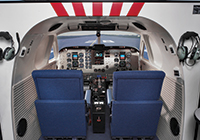
Features
Safety
45º 42′: North: Turning vision into reality
Nimble, forward-looking and seeking to develop best practices and excellence in all areas of the operation. It’s a strong recipe for success and the governing philosophy of new Canadian aviation firm Ottawa Aviation Services.
November 3, 2011 By Peter Pigott

|
|
Nimble, forward-looking and seeking to develop best practices and excellence in all areas of the operation. It’s a strong recipe for success and the governing philosophy of new Canadian aviation firm Ottawa Aviation Services. The team wouldn’t have it any other way, says Cedric Pallaird, vice-president of marketing (and one of the firm’s partners).
An ultra-modern aircraft fleet, keen instructors and the latest flight training devices (FTD) are essential to achieving excellence in such a competitive market and one of the measures of OAS’s success is its aircraft. The envy of other local aviation schools, OAS uses the elegantly beautiful Diamond Aircraft Katana DA20 for ab-initio training; the sleek Diamond Star DA40 for glass cockpit advanced and IFR training; a fully aerobatic (to +6G and -3G) Grob G115C; and a Piper Seneca II for multi-engine training.
Ottawa Aviaition Services has also supported Canadian simulator expertise by getting an Ascent Turboprop Trainer from Montreal-based Mechtronix Systems Inc., the Flight Simulation Training Devices (FSTD) manufacturer. Configured as a generic regional turboprop with conversion kits to multi- and single-engine piston, the FSTD is used for ab-initio training, Turbine Transition, Crew Resource Management as well as Instrument Flight Rating.
Before getting into an aircraft, students take 10 hours of flight training on the FSTD followed by the insertion of scenario-based training. Because of the Mechtronix simulator capabilities, OAS has partnered with Seneca College in its National Science and Engineering Research Council project to study simulator time as an alternative means of compliance in ab-initio training.
“We also partner with Algonquin College and Carleton University in Ottawa to offer training to their aeronautical engineering departments,” Pallaird says. “Carleton University provides 15 students – seven of which do a co-op. They fly and work, and what they work at goes towards their flying. With us, Carleton graduate students are also working on simulator development. They cut up one of our old Katanas, took it to the lab and with a local high-tech company, Beacon Engineering, built their own simulator.” OAS hopes this “sim” will be approved by Transport Canada by June 2012. This joint research project with OAS maintenance staff is studying the effects of aging on composite aircraft.
When asked about OAS student intake, Palliard said about 30 come from Algonquin College annually and the remainder from advertising – an annual intake of 70 students on average. Once at OAS, they have access to Recreational Pilot Permit, Private Pilot Licence, Commercial Pilot Licence, Night Rating, Instrument Training, Instructor Rating, Multi Engine Rating, Aerobatic Rating and an RCAF Preparation Course. OAS is launching a professional pilot program structured so the students are actually on a timeline that has glass cockpit, upset recovery components and the simulator.
So, what does OAS offer that other institutions do not? “We have pioneered Pilot Assessment Services,” Paillard says. “The first formal pilot assessment centre in Canada has been set up here at Ottawa International Airport. It’s open not just to our own students but to all aspiring pilots and operators. When a student comes to OAS, the first thing they do is a four-hour assessment exercise. We assess them in eye/hand co-ordination, mathematics, orientation and task management – things essential to a pilot. We then show them the results and tell them this is where you can improve and this is how we can help with remedial work. We are the only school in Canada to offer this.”
Although the simulator and pilot assessment centre are at the modern Innotech-Execaire Centre, the main OAS offices are dated and next to a giant Chinese food store. When asked if they planned to vacate, Paillard laughs and says they actually liked being there – it provides some “character.” However, they are discussing building their own premises.
In terms of foreign markets, OAS is just now gaining traction in Asia.
With the FSTD, the Diamond fleet, the research projects and the pilot assessment centre, there’s no doubt OAS has successfully identified a strategy for translating its vision into reality.